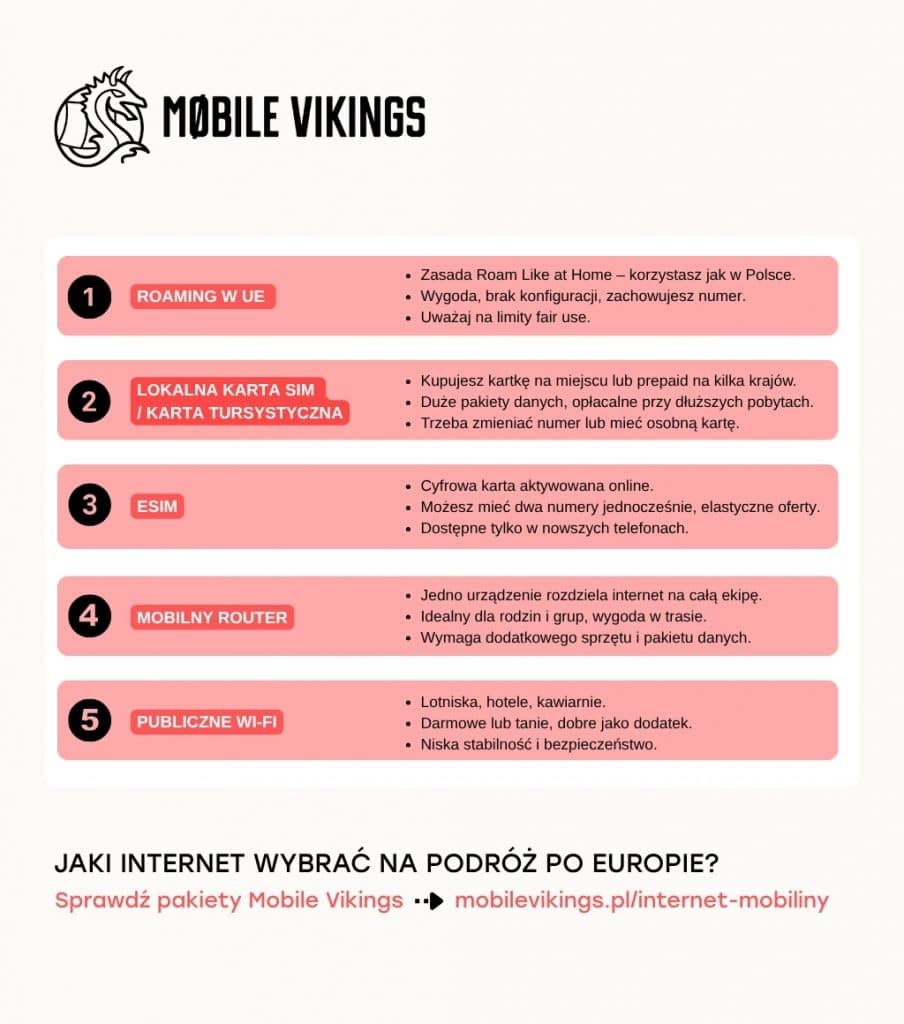Are you embarking on a European cruise – maybe to Rome, Barcelona, or the Norwegian fjords? Suitcase packed, tickets bought, but one question remains: what internet for Europe should you choose to ensure convenience on your journey, like sailing on calm waters? This guide will help you set a course for the best solution!
Key information from the article
- Internet when travelling is a must-have – needed not only for social media, but also for maps, reservations, or contacting loved ones.
- There are several options – EU roaming, local SIM card, tourist prepaid cards, eSIM, mobile router, or public Wi-Fi.
- EU roaming operates on the „Roam like at home” principle – you use your data package as you would in Poland, but a fair use limit applies.
- Alternatives – a local SIM or eSIM are suitable for longer trips, high data demands, or travel outside the EU.
- Data consumption depends on your travel style – a city break is 1–2 GB, a week in Europe is approx. 5–10 GB, and longer journeys can be up to 20 GB.
What internet to choose for Europe and why you'll be like Thor without his hammer without it?
Travelling without internet is like sailing without a map. Sure, it's possible, but is it worth going against the current? Contrary to appearances, the internet is useful not only for scrolling social media.
It's primarily for:
- maps and navigation in new cities,
- quick checking of timetables and attractions,
- hotel or ticket reservations on the go,
- contact with loved ones,
- the ability to learn or work,
- and sometimes even a rescue, when you need to check local rules or regulations.
Did you know that knowledge is worth its weight in gold? Discover new waters and check what exactly mobile internet is.
What internet for Europe – let's check the options
When travelling in EU countries, you have several solutions to choose from.
- EU Roaming – you use your operator's package as you would in Poland.
- Local SIM card – you buy a card locally in a given country.
- Tourist prepaid cards – available at airports and in shops, covering several countries.
- eSIM – a fast, digital alternative, activated online.
- Mobile router or Wi-Fi – an additional device that shares mobile internet with several devices.
Each option has its pros and cons – let's see how they perform in practice.
Remember that internet for holidays is an anchor that keeps your trip in check – whether you're going on a city break to Berlin or a two-week road trip through the Balkans.
EU Roaming
In European Union countries, the "Roam like at home" principle applies. This means you can use the internet within your package without additional costs.
Advantages of EU roaming:
- full convenience – you don't have to configure anything,
- you keep your phone number,
- you use your mobile operator's reliable network.
What to watch out for:
- the fair use policy applies – surcharges may appear after exceeding a certain data limit,
- different offers have different limits, it's worth checking them before you travel.
You can find more about this in the guide: how foreign roaming works and how it differs from international calls.
Local SIM card or tourist card
Roaming is convenient, but not always the most cost-effective option. If you plan a longer stay in one country, are travelling outside the European Union, your operator offers a low roaming limit, or you simply need large data packages, then it's worth considering a local SIM card. Buying a card abroad is not a problem today – you'll find them at airports, in shops, or operator showrooms.
For touring trips, e.g., in the Balkans, a tourist prepaid card that covers several countries simultaneously works well. This way, one internet package works in many places, and you don't have to buy a new card at every border.
eSIM, or the digital version of a SIM card
An increasingly popular solution for travel is eSIM, the digital version of a traditional SIM card. Thanks to it, you can use two operators simultaneously – your main number and an additional internet package. This solution offers great flexibility: you can buy a package only for the duration of your trip, easily switch between numbers and tariffs, and retain your permanent number.
Mobile router and Wi-Fi
Sometimes, the whole crew sets off on a trip around Europe. In that case, it pays to take a mobile router – one device that shares mobile internet with several phones or laptops. This is a good solution for families or teams working remotely on the road, for example. On the other hand, using public Wi-Fi (airports, hotels, cafes) is convenient but not always secure and stable. A Viking's word that it's better to treat it as an addition rather than the main source of internet.

How much internet do you need for your holiday?
Your data needs depend on the length of your trip and how intensively you use the network. For a city break, 1-2 GB of internet will be useful. A week in Europe is already 5-10 GB, and a longer stay may require up to 15-20 GB.
Stop here for orientation and see how much data individual activities consume:
- one hour of GPS maps is 5–10 MB,
- one hour of social media scrolling is approx. 150 MB,
- a video call is approx. 300–500 MB,
- an HD film consumes 1–2 GB.





